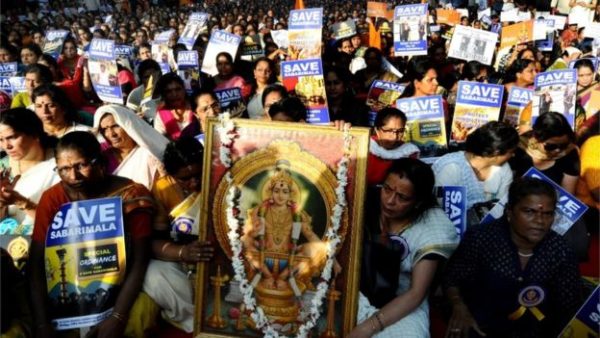The Sabarimala temple in the south Indian state of Kerala this week opened its doors to women of all ages for the first time after a historic Supreme Court ruling. However no women devotees have yet entered as violent protesters have blocked their way.
Two women – journalist Kavitha Jagdal and social activist Rehana Fathima – managed to reach the main temple premises on Thursday. More than 100 policemen protected them from stone-throwing protesters as they walked the last 5km (3-mile) stretch to the temple.
But they had to return after a stand-off with devotees metres from Sabarimala’s sanctum.
The protesters have also included many women – they have participated in rallies, blocked roads and checked vehicles heading towards the temple to see if any women of a “menstruating age” – deemed to be those aged between 10 and 50 years – were trying to enter.
The temple attracts millions of devotees from across the country every year.
Why are protesters so angry?
Part of the violent opposition to the Supreme Court order to reverse the temple’s historical ban on women is because protesters feel the ruling goes against the wishes of the deity, Lord Ayappa, himself.
Hinduism regards menstruating women as unclean and bars them from participating in religious rituals.
But while most Hindu temples allow women to enter as long as they are not menstruating, the Sabarimala temple is unusual in that it was one of the few that did not allow women in a broad age group to enter at all.
Hindu devotees say that the ban on women entering Sabarimala is not about menstruation alone – it is also in keeping with the wish of the deity who is believed to have laid down clear rules about the pilgrimage to seek his blessings.
Every year, millions of male devotees trek up a steep hill, often barefoot, to visit the shrine. They also undertake a rigorous 41-day fast, abstaining from smoking, alcohol, meat, sex and contact with menstruating women before they begin the journey.
What is the legend of Lord Ayappa?
Every god in the vast Hindu pantheon has his or her own personality, complete with a unique legend, and Lord Ayappa is no different.
According to the temple’s mythology, Lord Ayyappa is an avowed bachelor who has taken an oath of celibacy.
There are several stories about why this is the case.
According to one legend, Ayappa was born out of a union between two male gods which gave him the ability to defeat a she-demon who had been unstoppable until then.
Upon defeating her, it was revealed that she was really a young woman who had been cursed to live the life of a demon.
She fell in love with him and asked him to marry her, but he refused, saying he was destined to go into the forest and answer the prayers of his devotees.
She persisted, so he said he would marry her the day new devotees stopped coming to seek his blessings.
That never happened.
The legend says that she waits for him at a second temple, which lies on the way to the main Sabarimala shrine.
Women do not visit either temple – the belief is that to do so would insult both the deity and the sacrifice of the woman who loved him.
According to another legend, Lord Ayappa was a prince who saved his kingdom from an Arab invader named Vavar.
Following the battle, Vavar became a devout follower of the prince – there is also a shrine dedicated to him near Sabarimala. He is said to protect the pilgrims who come to Sabarimala to seek blessings.
In this version of the story, Lord Ayappa eventually took a vow to answer the prayers of every devotee who came to him, and shunned all worldly desires including contact with women, which is why women are not permitted inside his temple.
There could also be other legends associated with the deity and why women are not allowed inside.
What are protesters saying?
“There is no jubilation among Hindu women devotees; on the contrary, they are distressed,” author Vineetha Menon wrote in the Organiser – a publication run by the Hindu nationalist Rashtriya Swayamsevak Sangh (RSS), which has been at the forefront of protests.
Ms Menon argues that women do not enter the temple “owing to the Lord’s bhava [wish]”.
Some male devotees have said that they will not return to the temple if the court ruling is enforced.
“We have been coming to temple for the last 30 years. But we may not come back because women entering the temple will spoil our belief system and sacred rituals,” Murugan, a devotee, told BBC Hindi’s Imran Qureshi.
The issue also divided the five-judge bench that gave the verdict.
Indu Malhotra, the only woman judge on the bench, disagreed with the majority verdict.
“Issues of deep religious sentiments should not be ordinarily interfered by the court… Notions of rationality cannot be invoked in matters of religion,” she said in her dissenting opinion.
Women have been demanding entry into the temple for decades. But in 2016, a controversial statement by the temple’s chief gave fresh impetus to the protest.
Prayar Gopalakrishnan said that he would allow women to enter only after a machine was invented to detect if they were “pure” – meaning that they weren’t menstruating.
Petitioners who appealed before the Supreme Court to lift the ban cited his statement, saying the temple’s rituals violated equality guaranteed under India’s constitution. They added that it was prejudiced against women and their right to worship.
Correspondents say that clashes between protesters and police may escalate in the coming days as more women are likely to attempt to enter the temple.



Leave a reply